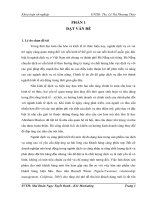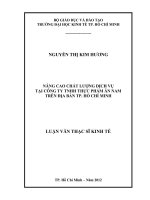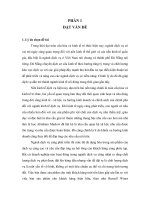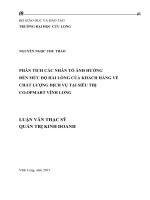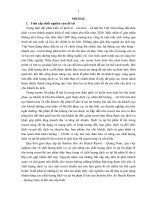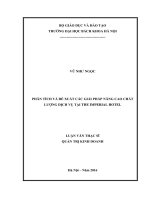Micro finance service quality the hoi an city, vietnam experience= chất lượng dịch vụ tài chính vi mô kinh nghiệm tại thành phố hội an, việt nam
Bạn đang xem bản rút gọn của tài liệu. Xem và tải ngay bản đầy đủ của tài liệu tại đây (2.03 MB, 184 trang )
MICRO-FINANCE SERVICE QUALITY: THE HOI AN CITY,
VIETNAM EXPERIENCE
________________
A dissertation presented to
The Faculty of the Graduate School
Bulacan State University
Bulacan
________________
In Partial Fulfillment
of the Requirement for the Degree
Doctor of Philosophy in Business Administration
Major in Finance and Banking
________________
PHU HA NGUYEN
2013
a
© 2013
Phu Ha Nguyen
ALL RIGHTS RESERVED
b
ABSTRACT
The dissertation attempted to evaluate perceived service quality of
micro-finance institutions operating in Hoi An and its impact on income
improvement and social equality of clients in Hoi An in 2010-2012.
Specifically, it sought answers to the following:
1. How is perceived service quality of MFIs in Hoi An in terms of: financial
outreach, tangibles, responsiveness, empathy, assurance, and reliability ?
2. How may the service quality of MFIs in Hoi An be described in terms of:
gender, age, education, types of business, years of relationship?
3. How may the
perceived service quality of MFIs influence income
improvement and social equality of clients in Hoi An?
4. Are there significant differences in perceived service quality among formal
and semi-formal sector MFIs in Hoi An when they come to providing
microcredit ?.
5. If there are, what underpins these differences?
6. What is a plan of actions to improve the effectiveness of the microcredit
program with aims to improve the financial and social positions of the
clients in Hoi An?.
Following a review on related theories, studies and literatures,
conceptual framework on service quality, and self-developed questionnaire
i
with a pilot study were done. Statistical frequency, reliability test, KMO and
Bartlett‟s test, factor analysis were utilized, and 9 hypothesizes were tested
using t-test and Pearson correlations.
Some findings and conclusions about Hoi An arrived at the following :
1. The clients shared common characteristics with those drawn in other
related studies in terms of female-focus lending, education, business type;
2. Evidence on clients‟ profile in terms of years of relationship shows that
MFIs in Hoi An are in the process to built up their client network.
3. The total sum of six dimensions including: “financial outreach”; “tangibility”;
“responsiveness”; “empathy”; “assurance”; and “reliability” can contribute
remarkably to the total variance of the overall perceived service quality.
Of which, “financial outreach” and “reliability” were most vital dimensions.
4. The overall service quality score of formal sector MFIs was higher than
that of semiformal sector MFI‟s.
5. The overall perceived service quality has significant impact on income
improvement and social equality of the clients.
6. Recommendations were made to management of MFIs include: MFIs‟
awareness in meeting with service quality standards, responsibilities of
clients to micro-credit conditions, and efforts to use loans efficiently.
Suggestions on an action plan include: sets of criteria and required steps.
Furthermore, there are also recommendations to future academic
researches based on limitations of the study.
ii
ACKNOWLEDGEMENTS
This study could not have been possible without the generous help of
a number of people who motivated, inspired, assisted, and supported the author
in her endeavor. Their names are gratefully acknowledged and their precious
memories will always be treasured.
To Dr. Andy NG YOKE BENG, the author‟s supervisor for his
precious time, experiences, knowledge, advice for modification from the
beginning to the completion of the study;
To the author‟s husband, children, mother in law for their
encouragement and taking care;
To the author‟s parents for being so supportive in time of needs;
To the micro-finance experts in Hoi An, whose advice for modification
of the survey questionnaire;
To Mr. Ne VO, People Committee of Cam An Ward, Hoi An City for
his great support;
To members of Hoi An Women Union for their time and efforts to
deliver and collect survey questionnaires;
To the respondents of the study;
To my beloved friend and colleague, Dr. Van DINH Thi Thanh for her
precious support.
Finally, all the study requires many hours of the author to writing and
typing
iii
LIKE THE MASTER THESIS, THIS DISSERTATION IS DEDICATED TO MY
HUSBAND AND MY CHILDREN BECAUSE OF THEM IS A CONSTANT
SOURCE OF INTELLECTUAL INSPIRATION AND TREASURE OF LOVE
iv
TABLE OF CONTENTS
Page
APPROVAL SHEET
COPYRIGHT PAGE
ABSTRACT
ACKNOWLEDGEMENTS
DEDICATION
TABLE OF CONTENTS
LIST OF TABLES
LIST OF FIGURES
ACRONYMS
i
iii
iv
v
vii
viii
ix
Chapter
1
1.1
1.2
1.3
1.4
2
2.1
2.2
2.3
2.4
2.5
2.6
2.7
3
3.1
3.2
3.3
3.4
THE PROBLEM AND ITS BACKGROUND
1
Introduction
Statement of the Problem
Significant of the Study
Scope and Delimitation of the Study
1
4
6
10
THEORITICAL FRAMEWORK
15
Relevant Theories on Service Quality
Relevant Theories on Microfinance
Relevant Literatures and Studies on Service Quality
Proposed Dimensions for Microfinance Service Quality
Measurement
Conceptual Framework of the Study
Hypotheses of the Study
Definitions of Terms Used in the Study
15
30
54
67
METHODOLOGY
79
Methods and Techniques of the Study
Population and Sample of the Study
Instrument of the Study
Method of Gathering Data
79
82
84
90
v
71
73
74
4
4.1
4.2
4.3
4.4
5
5.1
5.2
5.3
5.4
PRESENTATION, ANALYSIS, AND INTERPRETATION OF
DATA
92
General Information on Client‟s Profile
Service Quality, Income Improvement, and Social Equality
Interpretation on Determinants of Service Quality
Hypothesis Testing
93
100
108
115
SUMMARY, FINDINGS, CONCLUSION, AND
RECCOMENDATIONS
123
Summary
Findings
Conclusion
Recommendations
123
124
128
130
REFERENCES
APPENDICES
CIRICULUM VITAE
END NOTES
136
158
167
171
vi
LIST OF TABLES
Table
Page
2.1
Outstanding loans of key formal sector MFIs
42
2.2
Outstanding loans of semiformal sector MFIs
43
2.3
Liabilities structure of core MFIs of Vietnam
45
2.4
Characteristics of Formal Sector MFIs and Semiformal Sector
MFIs
46
2.5
Comparison of prior vs. post poverty reduction (%) of
microfinance clients in Vietnam
51
2.6
Critical Contac Points to Dissatisfaction with Customer Service
63
4.1
Frequency Distribution of Gender
94
4.2
Frequency Distribution of Age
95
4.3
Frequency Distribution of Education
97
4.4
Frequency Distribution of Business Type
98
4.5
Frequency Distribution of Years of Relationship
100
4.6
KMO and Bartlett‟s Test for Service Quality
101
4.7
Factor Analysis with Principle Dimensions and Items after
Rotation
103
4.8
Factor Analysis with Dimensions and Items after Rotation
107
4.9
Mean Comparison for Accessibility, Funding conditions,
Costs/price; Tangibles; Responsiveness; Empathy; Assurance
116
4.10
Independent Sample T-Test
117
4.11
Pearson Correlations
120
4.12
Results of all the hypothesizes tested
122
vii
LIST OF FIGURES
Figure
Page
2.1
Gronross and ROM Models
24
2.2
SERVQUAL and SERVPERP Models
27
2.3
The Country Context
31
2.4
Microfinance Network in Vietnam
41
2.5
Clients Characteristics
47
2.6
Vietnam microfinance: Gender structure of clients
49
2.7
Geographical segment in Vietnam microfinance market
52
2.8
Service Quality Measurement
57
2.9
Clients Satisfaction on Funding Conditions and Trusts in
Vietnam‟s MFIs
58
2.10
Customer Satisfaction
60
2.11
Matching Two Sets of Dimensions used in Measuring Service
Quality in Microfinance
69
2.12
Matching the Common Dimensions developed by S.A Buddhika
(2006) and E.K. Balemba (2009) with Parasuraman et al.,
Framework (1998)
70
2.13
Conceptual Framework of the Study
71
viii
ACRONYMS
Agribank
The Agriculture Development Bank of Vietnam
CCF
Central Credit Fund
CGAP
Certified Government Auditing Professional
CEP
Capital Aid Fund for Employment of the Poor
HWU
Hoi An Women Union
NGOs
Non-Governmental Organizations
MFIs
Micro-Finance Institutions
MUCTC
Montreal Urban Community Transit Commission
PCA
Principle Component Analysis
PCFs
People Credit Funds
QSO
Quang Nam Statistics Office
SBV
State Bank of Vietnam
VBSP
Vietnam Bank for Social Policies
VMWG
Vietnam Micro-Finance Working Group
VSO
Vietnam Statistics Office
WAGES
Women and Association for Gain both Economic and
Social Development
WTO
World Trade Organization
Chapter 1- The Problem and It’s Background
1.1- Introduction
Hoi An city (“Hoi An”), which is located in Quang Nam province - Vietnam,
is home to approximately 120,000 inhabitants. As one of the third-class cities in
Vietnam, Hoi An is not only recognized by the UNESCO‟s certification of World
Cultural Heritage since 1999 but also said to be a well served place for
microfinance analysis with the outreaching of microfinance industry in recent
years (K. A, Nguyen 2011).
There are four main sources of information on
microfinance and poverty alleviation – Quang Nam Statistics Office (“QSO”),
Vietnam Bank for Social Policies (“VBSP”) Hoi An Branch, The Agriculture
Development Bank of Vietnam (“Agribank”) Hoi An Branch, and Hoi An People
Credit Funds (“PCFs”). According to the “2011 Statistical Year-Book” by QSO,
Hoi An had 10,066 near-poor households and 2,966 poor ones, accounting for
33.55 percent and 16.55 percent of its total population respectively1.
The
permanent appearance of microfinance institutions (“MFIs”) in association with
the economic policy launched by the local government developing the city
towards “trade, tourism and services” would support the low income clients with
more opportunities to access to microfinance services.
Hoi An microfinance
industry is expected to reach over 15,000 active clients by 20152. Besides, the
rapid growth of Hoi An‟s microfinance sector has brought about strong
1
competition among MFIs, highlighting the critical need to establish long-term
relationship with clients and to attract new customers by offering higher service
quality.
For the past several decades, research on microfinance have focused
predominantly on two goals: the role of microfinance as a tool for alleviating and
reducing poverty, and impact assessment of microfinance on client outreach and
financial sustainability (Basu et al, 2004; Pal, 1999; Porter, 2003). Substantial
progress has been made in understanding the movement of microfinance from
only social welfare approach to balancing both the two goals: the social welfare
and financial sustainability (J. Ledgerwood et al, 2000). However, progress in
understanding the needs to take care clients with better service quality and
responsibilities of clients in funding conditions commitments, especially the effect
of microfinance service quality on income improvement, job creation, social and
psychological empowerments for low-income clients have been much slower
because of few studies and literatures. Therefore, there is a significant gap that
the author would like to undertake to further contribute to the scanty literatures,
particularly in the context of Vietnam.
Nowadays, service quality has a correlation of best practices and
principles in providing financial services to the clients through image and
philosophy, client selection, loan policies, disbursement and monitoring, client
incentives, culture of zero tolerance, and management of information system,
2
etc...(Rarimi et al, 2003).
Service providers need to be conscious of providing
reliable and timely services to their clients while clients need to see whether they
should lay the truth or confirm their loyalty with the service providers.
That
continued interactions are key tenants to the success of every service provider.
It is certain that service quality plays an important role in the customer‟s
service experience. Better service quality increases perceived service value and
improves the service provider‟s customer retention and financial performance
(Cronin et al, 2000; Nguyen et al, 1998; Rust et al, 1993). The great emphasis
on service quality has given birth to multiple studies and innovative
methodologies to assess and to understand client behavior.
On this basis, the present study aims to provide an useful adaptation of
the SERVPERF‟s methodology to measure service quality, which is created by
Cronin and Taylor (1992), accompanying with 6 dimensions that obtained from
SERVQUAL‟s framework provided by Parasuraman et al, (1988) and indicators
appropriate to the specific conditions of microfinance in Vietnam. They would be
“financial outreach” which includes accessibility, funding conditions, costs/price,
“reliability”,
“tangibles”,
“responsiveness”,
“empathy”,
“assurance”,
and
“reliability”. The study would use the 6 dimensions as main drivers in evaluating
perceived service quality, and its impact on income improvement and social
equality of low income clients in Hoi An. The proposed hypothesizes will be
tested against data collected from a survey method distributed to clients using
3
micro-finance services in the geographic area of Hoi An.
Furthermore, the
results of the study could provide guidelines and directions to the managerial
level for arranging appropriate strategies in microfinance sector.
1.2- Statement of the problem
Successful institutions provide good quality services that are reliable and
timely. In the research on best practices and principles in microfinance, I. Karimi,
(2003) confirms that the institution must look at microfinance as a profitable
business, not just as a social commitment. He also stresses that clients should
also understand that microfinance is a financial services and not a
government/donor funded loan or some social service that the MFI is providing.
Well-run financial institutions develop a long-term financial service relationship
with their clients that continues throughout the life of the client and his/her family.
Meanwhile, other studies also found that microfinance towards social economic
performance must ensure good quality services, demand-oriented savings & loan
products, good client selection process, sufficient interest rates to cover costs,
zero tolerance against loan delinquency, and good management information
system (Hoang, 2011; Goodwin-Groen, 2012).
It is certain that sustainable
development of MFIs are close to the service quality providing to clients. The
modern model of microfinance has focused on both developing financial
sustainability of MFIs and improving income, job creation, gender empowerment
4
for the poor, diminishing the development of traditional moneylenders for the
whole financial system (I. Karimi et al, 2003; Bateman, 2010). Efforts undertaken
to achieve these social welfare and business aims are also reflected the degree
at which clients perceive the service quality.
As service quality plays a vital role in the success or failure of an
organization, the study does focus on the significance of perceived service
quality in the context of microfinance.
Specifically, it aims to address the
following questions:
1. How is perceived service quality of MFIs in Hoi An in terms of:
1.1. financial outreach
1.2. tangibles
1.3. responsiveness
1.4. empathy
1.5. assurance
1.6. reliability ?
2. How may the service quality of MFIs in Hoi An be described in terms of:
2.1. gender
2.2. age
2.3. education
2.4. types of business
5
2.5. years of relationship?
3. How may the perceived service quality of MFIs influence income improvement
and social equality of clients in Hoi An?
4. Are there significant differences in perceived service quality among formal and
semi-formal sector MFIs in Hoi An when they come to providing microcredit ?.
5. If there are, what underpins these differences?
6. What is a plan of actions to improve the effectiveness of the microcredit
program with aims to improve the financial and social positions of the clients in
Hoi An?.
1.3- Significance of the study
The target of microfinance in Vietnam nowadays is much different from
those before 20063. Before 2006, Vietnam microfinance was regarded as an
effective tool to reduce poverty and alleviate hunger (CCF, 2010). However,
microfinance in Vietnam today serves clients
for the two simultaneous
objectives: social performance and commercial performance.
6
As for social performance‟s perspective, it can be seen that Vietnamese
Government always aims at aspects of poverty reduction and hunger alleviation
of microfinance.
The National Project Development on Microfinance Industry
Towards 2020 issued by SBV has stressed that the Government “pursues targets
to use microfinance as a social tool to reduce poverty and alleviate hunger”
(SBV, 2011). For the last two decades, three core state-owned MFIs including
the Agribank, the VBSP, and the CCF have been recognized to have remarkable
contributions to the success of microfinance (VMWG, 2011).
Statistical data
announced by VSO that poverty rate4 of Vietnam fell consistently from 58% in
1993 to 37.4% in 1998, 28.9% in 2002, 16% in 2006, 14.5% in 2008, and 14.2%
in 2010 has proved that socio-economic conditions in rural areas of Vietnam has
been improved substantially.
At present, the poverty rate is still higher than
some of other Asian countries (i.e., 3.8% for Malaysia, 12.5% for Indonesia, 8.1%
for Thailand according to statistical data announced by the World Bank).
Therefore, the role of microfinance in combating poverty remains important
towards coming years (VMWG, 2011).
As for commercial performance‟s perspective, most MFIs in Vietnam
nowadays operate under a legal framework that is common to all banking and
credit institutions. Especially, since Vietnam participated to become an official
member of WTO, microfinance environment has undergone substantial
developments towards financial liberalization (T.Nguyen et al., 2011).
The
reduction of state budget and donor funds in capital resource of some leading
7
MFIs in Vietnam is considered to be the most recognized. According to data
announced by VSO in 2011, the ratio of state budget and donor funds of three
core MFIs (Agribank, VBSP, and CCF) reduced from 48%, 68%, and 38% in
2002 to 17.1%, 23.1%, and 16.48% respectively as of 2010 (SBV, 2011).
Alternatively, the three core MFIs have step by step diversified their capital
resource through mobilizing and borrowing from the market. Up to 2010, the
alternative sources of funding for state budget - mobilized and borrowing fundswere 63%, 60.8%, and 78.29% respectively.
That most MFIs fund their capital
resource have to pay interests and fees force them focus more on lending
policy towards
revenues and profit, and try to offer better customer service
(VMWG, 2011).
More significantly, environment policy of microfinance in Vietnam has
undergone substantial development since
the issuance of Decision No
2195/QD-TTg on Dec 6, 2011 by the Government to approve the transformation
of semi-formal and informal MFIs (their definitions and characteristics are
illustrated in chapter 2) into the formal entities, issuing the regulatory framework
for licensing and operation of MFIs towards privatization and commercialization
under joint-stock financial intermediaries; and promoting financial self-sufficiency
of MFIs. The number of MFIs operating in Vietnam has increased steadily from
10 in 2002 up to 49 formal and semi-formal MFIs in 2010. It is obvious that
competitions among them would be more intensive as every MFI has to generate
income ensuring its long-term development (SEEP, 2012).
8
As for marketing and sales strategies, service quality is an effective tool to
help MFIs be more competitive towards sustainable development (CGAP,2010).
In the past, Vietnam microfinance industry often neglected the aspects of service
quality providing to low income and poor clients.
Differently, microfinance
nowadays is both a social performance and a business operating in a potential
market with population of nearly 85 millions and approximately 70% of them
living in rural areas (T. Nguyen et al., 2011, M. Bateman, 2010).
These basis would help the author concrete more on the significance of
perceived service quality to the sustainable development of MFIs and the impact
of service quality to key social issues. In which, the author would build up sets of
dimensions to evaluate service quality, making analysis on whether it has impact
on income improvement and social equality of clients; and trying to find out if
there is significant difference in service quality among different types of MFIs.
During conduction of the research, the author always sets geographic area of
Hoi An as study location since it is a well serve place for microfinance analysis
(the existence of 22 leading formal and semiformal MFIs operating in the same
time (QSO, 2010). Moreover, the 20% annual expansion of microcredit in Hoi An
is a good signal for practitioners and local government to observe and evaluate
the impact of the important sector on improving economic and social
performance (HWU , 2012).
9
1.4- Scope and delimitation of the study
Scope
According to statistical data announced by QSO, the geographic area of
Hoi An comprises of nine wards and four communes with about 120,000
inhabitants. The present study intends to investigate the service quality of MFIs
operating within this boundary. Thus, main subject of the study must be the
service quality of MFIs, which is measured by the perception of clients using
micro financial services in Hoi An. Point 4, Provision 5 of the 47th Law on Credit
Institutions of Vietnam, formal sector MFIs comprise of Vietnam Bank for Social
Policies (“VBSP”), The Agriculture Development Bank of Vietnam (“Agribank”),
People Credit Funds (“PCFs”), semiformal sector MFIs include ROSCA-type,
local groups, NGOs, and micro-finance programs, while informal sector MFIs
include money lenders, landlords, shopkeepers, friends and relatives. Although
MFIs include three main types as formal, semi-formal, and informal ones basing
on this law, the present study limits its subject of study just within the boundary of
perceived service quality of regulated MFIs, which is covered formal sector and
semi formal sector entities,
and it does not cover informal sector MFIs
(characteristics of these formal sector and semi-formal sector MFIs would be
discussed in detail in chapter 2).
10
J. Ledgerwood (2000) has indicated in his microfinance handbook that
there are four categories of microfinance services providing to clients, which
includes:
Financial intermediation: or the provision of financial products and services
such as credit, savings, insurance, credit cards, and payment systems.
Social intermediation: or the process of building human and social capital
required by sustainable financial intermediation for the poor.
Enterprise development services: or non financial services that assist microentrepreneurs. They include business training, marketing and technology
services, skill development, and subsector analysis.
Social services: or nonfinancial services that focus on improving the wellbeing of micro-entrepreneurs. They include health, education, and literacy
training.
As the matter of fact that microfinance products and services provided by
MFIs in Hoi An are undiversified with majority of product range as being
microcredit.
According to the 2011 annual reports announced by VBSP,
microcredit accounts for approximately 81 percent of the total services, and
individual based lending made up about 73 percent of the total clients.
Therefore, within the framework developed in the present study, main focus
would only include microcredit for individual clients. The term “clients” has been
used in many literatures and studies on microfinance (D. Mallick, 2011; C.
11
Waterfield, 2011; J. Copestake, 2007; R. Dixon et al., 2007; A. Dowla, 2006;
Q. Ma et al., 2005; T. Arun, 2005;
E. Rhyne, 1992), whereas the term
“customers” has been frequently used in those of service quality in the context of
marketing and commercial banking (H. Tohidi et al., 2012; Y.H. Chen, 2011; R.
Ladhari et al, 2011; J. A. Martinez et al., 2010; R. O. Large et al, 2009; k.
Choudhury, 2008; C. A. Albacete-Saez et al., 2006; L.T. Bei et al., 2006; J. M.
Hay et al., 2006; O.M. Karatepe et al., 2005; L.L. Stanley et al., 2002; A. C.
Soteriou et al., 1998;
J. Harvey, 1996).
According to the English Oxford
Dictionary online, the term “client” is referred to someone who received a
particular service while “customer” is referred to someone who buy and use a
certain type of products or services. In this regards, the term “clients” is used in
the present study would be more traditional within the context of microfinance.
Furthermore, it denotes people who access, select, and use services of MFIs are
mainly the low income living in the geographic area of Hoi An.
Delimitations
Limitations on focus groups of clients
Clients using microcredit in Hoi An can be divided into two main
categories, which includes individual-based lending and organizational-based
lending. Individual-based lending consists of low income women who represent
their households, or poor widower, or students who borrow money for their tuition
12
fees in the beginning years in universities or vocational training establishments.
Organizational-based lending consist of microenterprises, group-based unit
lending.
However, according to the characteristics customers in Hoi An,
individuals make up 73 percent of the whole clients population. This present
study, therefore, covers only individuals as the representatives for the whole
population of clients in Hoi An.
Although the author knows that the
disadvantages of focusing on individual client as the focus group of clients might
result in highly subjective and are likely to go beyond the person or persons
looked at.
However, the advantages of this level of investigation is that
individual clients are easily defined and identified. They can be surveyed or
interacted with in focus groups through interviews or participant observation.
Among the impacts to be sought at this level of clients are changes in income,
allocation of income (to pay for food, children education, for example), changes
in behavior (such as willingness to take risks), changes in status or sense of self,
and so on.
Problem of collecting data
Since a large number of clients are not using emails except for some
student clients, so the author has to ask for the help of seven members of Hoi An
Women Union (“HWU”) with direct delivery mail to clients‟ home or business
location, and waiting them finished and collected by hand.
13
There are two sets of questionnaires utilizing in gathering the necessary
data in the present study.
The first one is questionnaires for respondents
representing the formal sector MFIs, and the second is for those representing the
semi-formal sector ones. Details of them would be discussed in chapter 3 and
chapter 4 of the dissertation. Clients of VBSP would be main representative of
the formal sector MFIs while clients of Auco Fund, CTC Hoi An and BeeGreen
would be representative those of semiformal sector MFIs.
Limitations on literatures and relevant studies
The author has spent time to look up various sources of information for
literatures and relevant studies on perceived service quality of microfinance. It
can be seen that researches adapting service quality models into the context of
microfinance have been very few except for some abroad including Buddkiha et
al., (2008); E.Balemba. K (2009), Ifad (2007), U. Jacqueline (2006), and Murray
(2001). In Vietnam, only one research report entitled Microfinance vs. Poverty
Reduction in Vietnam-Diagnostic Test and Comparison in 2011 would be found,
which contains discussion on the clients‟ satisfaction of microfinance services,
and the comparison of prior vs. post levels of income, consumption, and saving.
Therefore, it is quite hard to make a comparison between findings of the study
and findings of some studies else.
14
